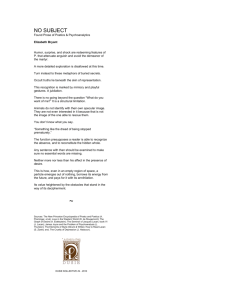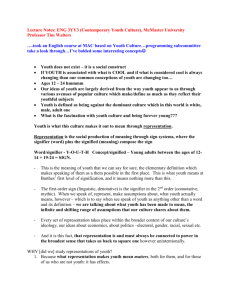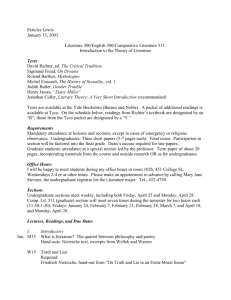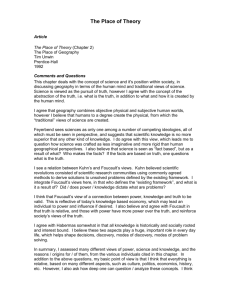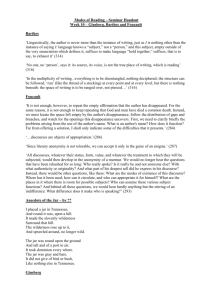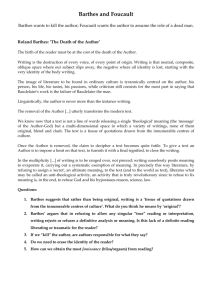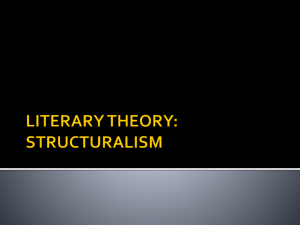Text - Image - Empty Signifier
advertisement
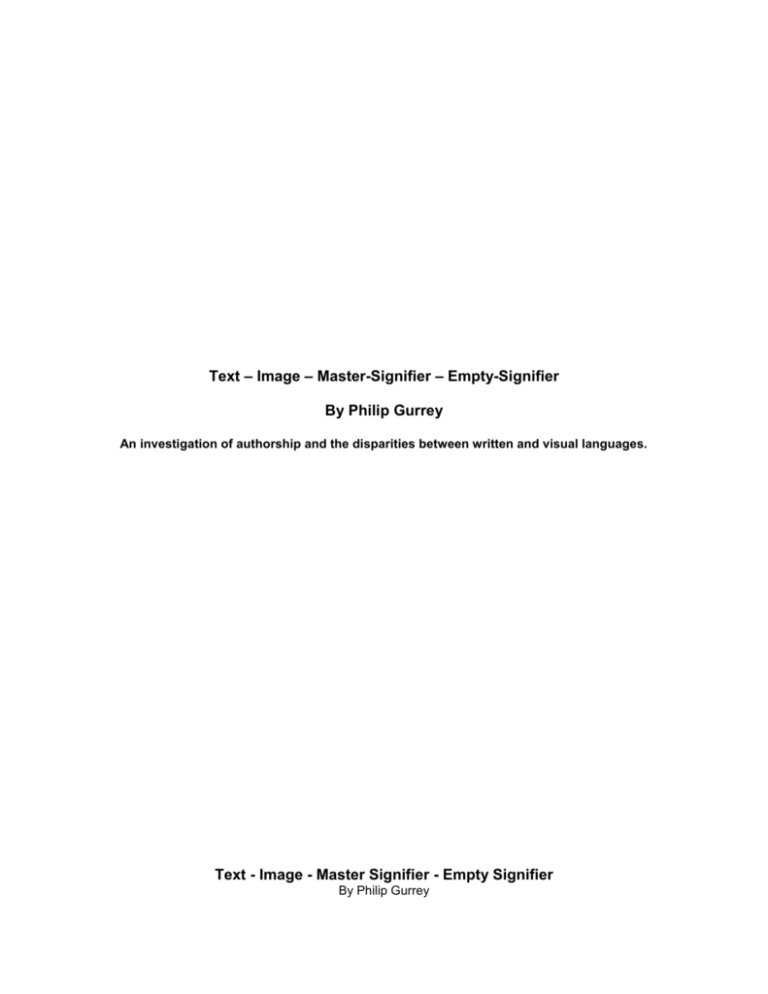
Text – Image – Master-Signifier – Empty-Signifier By Philip Gurrey An investigation of authorship and the disparities between written and visual languages. Text - Image - Master Signifier - Empty Signifier By Philip Gurrey Introduction Michel Foucault set down in his seminal text ‘What is an Author?’ two parallel properties of authorship: 1. Author – Individual 2. Author – Function. He directly relates authorship to a sense of absence, by coupling this play with absence to death. In stating that, ‘The trace of the writer is found only in the singularity of his absence.’ 1Foucault denounces the idea of author as vehicle for meaning, stating that ‘it is language which speaks not the author.’2 ‘He (the author) must assume the role of a dead man in the game of writing.’ 3My aim within this text is to extrapolate upon this investigation of authorship, with a clearer emphasis laid upon the visual, through photography and finally into painting. This written investigation will force a wedge between the written/spoken word and the language of the visual. By delving into this void I will address some of the underlying issues at work in bridging these two very separate languages be that through theoretical or journalistic vehicles. My line of inquiry, will address the difference in effect of ‘quotations’ within written and painted languages. I will address ideas circulating around the master-signifier and empty-signifier alluded to by Zizek in an attempt to question political and social narratives that arise from the relationships between Artist – Work – Viewer. Background Text/Photograph/Painting/Object/ Artist/Author Viewer/Subject The author - function: without an author there would be nothing for us to read/see, as the work has to be created by someone or something. The author - individual relates to the presence of the creator which lines on the periphery of the text or work, which we are confronted with. 1 The Foucault Reader: An Introduction to Foucault’s thought – Michel Foucault, Penguin 1991 2 Ibid. 3 Ibid. The author and the reader only enter into the work on the condition that they remain unexpressed init. Prior to Foucault’s developments upon the theme of author (individual), Roland Barthes alluded to a similar issue in his work ‘Image, music, text’: ‘The explanation of the work is always sought in the man or woman who produced it, as if it were always in the end, through, more or less transparent allegory of the fiction, the voice of a singular person, the author ‘confiding’ in us.’4 The scepticism alluded to here refers to the way in which an ‘original’ work comes into existence. With emphasis upon author as creator of words, sentences and texts, Barthes forces us to question where is it in fact these words and sentences arrive from? Is language not taught, borrowed, reinterpreted? Is it not a series of signs, symbols and references, which an author realigns or re-appropriates through his or her own voice/style? Within The Death of the Author we are made potently aware of the idea that man is born into a pre-existent set of linguistic devices which he has to learn and master. They are around before he is born and they will exist after his death. ‘We know now that a text is not a line of words releasing a single ‘theological’ meaning but a multi-dimensional space in which a variety of writings, none of them original, blend and clash.’5 The very nature of common language then is a collaboration and conglomeration of signs and signifiers. What role then does the author (individual) take retrospectively? What does it mean to try and bridge the gap between author (function) and author (individual)? Can they exist independent of themselves? ‘Once the author is removed, the claim to decipher a text becomes quite futile. To give a text an author is to impose a limit on that text, to furnish it with a final signified, to close the writing.’6 The author (individual) caps the very freedom of language itself by imposing his/her time, place and social status etc… upon the work. Does this render language meaningless out with its author (individual) status or context? What comes into question is the relationship between the physical and the symbolic. Language is not concrete it is merely a set of devices, signs, symbols which refer to an-other. Language then can never truly, legitimately penetrate its subject; language like the author (individual) in retrospect creates meaning around their subject. Subjects themselves 4 Image, Music, Text – Roland Barthes, Fontana Press 1993 5 Image, Music, Text – Roland Barthes, Fontana Press 1993 6 Ibid. begin to resemble their description/descriptors. This paradox is given further clarity and legitimacy by Rex Bulter in his essay Slavoj Zizek Master-Signifier: ‘The very success of a signifier in casting its light over others is also its failure, because it can do so only at the cost of increasingly emptying itself of any determinate meaning, or because in doing so it can always be shown not to be truly universal, to leave something out.’7 In order to make the leap from written language into the visual I have focused my investigation upon rather modernist ideals, born out of a Kantian dialectic and guilty in part of a Hegelian notion of a work of art returning to, or folding back in on itself, in order to cast further light upon the difference found between what is pre-existent or apparently behind the transcendental meaning of the thing-in-itself, and the empty signifier or retrospective meaning. I am at pains to highlight the link between the death of the author (individual), as set down by both Foucault and Barthes at this point, to the work as it exists in, and to itself. Language cut off from its author can be considered unique of itself and for itself alone, existing with no prior necessity or contextual devices. It exists as-it-is-in-itself. ‘Writing is the destruction of every voice, of every point of origin. Writing is that neutral, composite, oblique space where our subject slips away, the negative where all identity is lost, starting with the identity of the body of writing.’8 Hegel firmly routed this noumenality within the visual through a somewhat mathematical distinction between what he considered the boundary and the limit, pitting language directly against its subject: ‘boundary is the external limitation of an object, its qualitative confines which confer upon it its identity (an object is “itself” only within the confines, in so far as it fulfils a set of qualitative conditions); whereas limit results from a “reflection-into-itself” of the boundary: it emerges when the determinateness which defines the identity of an object is reflected into this object itself and assumes the shape of its own unattainable limit, of what the object can never fully become, of what it can only approach into (bad) infinity – in other words, limit is what the object ought to (although it never actually can) become.’9 7 Slavoj Zizek, Master-Signifier – Rex Butler, Rex Butler & Lacan.com 2004 8 Image, Music, Text – Roland Barthes, Fontana Press 1993 9 For They Know Not What They Do: Enjoyment as a Political Factor - Slavoj Zizek, (Radical Thinkers Series 3), Verso 2008 One is made particularily aware here of a physical relationship between language and subject and that of object and viewer. This degree of seperation should also include the author (function). It is indeed true that through creating one ligitimises ones own objectivivty to subjuct, through direct expression one reveals the absence of his or herself, the author (function) kills off the author (individual). ‘There is no subject which acts without another which watches it act, and which grasps it as acted, itself assuming the freedom of which it deprives the former.’10 The reader – Author – Individual relationship then is supplanted by the viewer – Artist – Individual firmly planted within the visual. What then of textual or visual referencing. If one is to ‘quote’ a particular text within another text, we borrow or re-contextualise that which has gone before, using the same set of symbols and signifiers, we reconstruct our own melody of sorts, in order to refresh or revitalise meaning and thought. This recapitulation of a prior text or work signifies plainly because it is of the same format or language. However what is to be made of visual quotation? How do we assert signification to a language, which is constantly in flux. First of all it is essential to open up the space further between written, spoken, textual language from the visual. Giorgio Agamben sets out this distinction through a focus on desire: ‘Desire as the visual, unable to be described in words. We are unable to put them into language because they are imagined.’11 This focus upon desire and the visual is key. We search as visual creative’s for something unexplainable, unpredictable, and unknowable. This visual search if referred to as desire appeals to our sense of need, yet it remains firmly routed in a visual working through, a physical ontological development of material and self, at the boundary of consciousness and limit, reflected within the noumenal intricacies of the void. We are then liable in the visual art field to determine this desire this un-transferable, imagined realm from language to the visual in its most meagre easily characterised self. By overlaying our obsession with the author/artist. ‘When the author has been found the text is ‘explained’ victory to the critic.’12 This over reliance upon everything but the work itself fills a void, which the work is clamouring to open up for the viewer to then exist within. By filling this void with the author, his/her background 10 Cinema 1: The Movement-Image - Gilles Deleuze, London and New York: Continuum, 2005 11 Profanations – Giorgio Agamben, Zone Books 2007 12 Image, Music, Text –Roland Barthes, Fontana Press 1993 history, race, class, social standing we seek to know more about the thing/work itself we are confronted with. However it is at this point caught within, an artworks political, cultural and social concrete signifiers that we have escaped the work itself, the visual! ‘There is a widespread assumption that if one is interested in the visual, one’s interest must be limited to a technique of somehow treating the visual. Thus the visual is divided into categories of special interest: painting, photography, real appearances, dreams and so on, And what is forgotten – like all essential questions in a positivist culture – is meaning and enigma of visibility itself.’13 Evidence 13 About Looking – John Berger, Bloomsbury Publishing 2009 Saint Cloud 1924 – Eugene Atget Saint Cloud 1988 - Christopher Rauschenberg The enigma of visibility is in danger of being lost in the literalness of language. The camera itself is a constant, a mechanised filter which itself is a common denominator in all photographs. This camera as starting point helps re-assert its difference from written language whilst simultaneously stamping its own photographic language on to its products. These images although one derived from the other are in fact vastly different in content. Rauschenberg depicts a barrier to the real by visually blocking our entry by use of the gate, throwing our eye up the curved pole and out into that bleak, crisp, open ended skyline. Where as Atget hems the viewers experience in with the arched top to his image, forcing the viewer down through the gate and into the murky, misty unquantifiable garden and trees. What we are confronted with then is an entirely new work of the same subject. A mimicking, yes, a reworking, however, the Rauschenberg image reverses the meaning inherent within Atget’s work through simulation, it neither adds something to the original nor inverts it. It sets itself up as master-signifier to Atget’s work by showing more clearly, when positioned side by side here, the process of photography itself. Set as a diptych it is no longer the subject or the artist (individual) under scrutiny here but the artist (function), purely and simply. Individual, subject and context all now position themselves behind the work itself. Self Portrait with Felt Hat – Vincent Van Gogh After Van Gogh – Sherry Levine ‘I am interested in making a work that has as much aura as its reference. For me the tension between the reference and the new work doesn’t really exist unless the new work has an artistic presence of its own. Otherwise, it just becomes a copy which is not that interesting.’ 14 By reinterpreting the significance of Van Gogh’s Self Portrait with Felt Hat Levine forces a wedge between our modernist experience of the hand of the author (function) and his or her peripheral role of author (individual). By referring to the notion of difference here, one can highlight the disparities found between language as descriptor and language as symbol. For instance ‘meaning is generated through the play of difference15’ A play very much a work in the two images above. ‘Underlying every “difference” is sexual difference.’ 16This re-iterates the principles sought by Levine herself, a re-capitulation of the most iconoclastic, masculine self-portrait, masculine in its execution, which is key. Re-appropriated by a woman, in reverse, in black and white, harbouring all the hall marks of Van Gogh’s direct expression. ‘Jacques Lacan sees sexual difference, the presence or absence of the penis, as the organising metaphor for all experiences of lack, thus the penis, physical is displaced by the phallus, symbolic.’ 17We have returned then to our investigation of language proper. Re-asserting our understanding of language proper, as a symbol (phallus) in a play with the real or physical (penis). Is Levine’s work then a symbolic reiteration of Van Gogh’s painting and indeed of Van Gogh himself in some ways? It is not mere symbol alone. To continue the metaphor further one might consider it a dildo to Van Gogh’s 14 www.artjunction.org - Sherrie Levine 15 Gender: Difference and Identity –John Calcutt, lecture, Glasgow School of Art 2nd May 2012 16 Ibid. 17 Ibid. penis. It is not an empty signifier it is still a work within itself, as Levine herself states, it still functions yet its physical nature is changed from that of its reference. Instability –Beyond the Symbolic Lacan reinforces the displacement from the penis to the phallus, from the physical to the symbolic. This lateral shift from what we experience to the explanation of how we experience highlights the key post structural paradox of origin and synthesis. A brief, coarse run through art history will, in effect highlight and become the paradox currently in question. Since the high renaissance and the work of Raphael, we have seen a dominance of author (individual) over author (function). The shift made at this time in 15th century Italy was crucial to the seismic shift from craft into art, the gradual autonomous move away from the artisan craft maker into the sought after artist (individual). This remains ever present today, where a preference for name over output seems to hold precedence, or does it? The two images above are not known for their author but as signifiers, political, social signifiers imbued with their inherent time and place. This would seem to be a poignant paradox to modernist ideas of meaning being derived from the thing as it exists in itself. As meaning is indeed divorced from its author here, yet significance is derived from the communication of signifiers in retrospect to the existence of these two particular photographs. The post-modern art as product has also lost significant ground as artist/label gives way to meaning as commodity, information as commodity. These photographs hold no significant artistic value in themselves however their meaning, their content or what they signify is colossal. Why then have I put these images side by side? it reinforces the instability of the master signifier. Any unified recognition or guarantee that the master signifier gathers can only be obtained from out side of itself (anti-modernism). Yet the outcome of this reliance on the borrowed, protracted, convoluted set of pre-existent symbols, language and its juxtaposition of free-floating ideological elements stands in for the void. ‘As with the order of language, this empty signifier or signifier without signified is the way for a self-contained, synchronic system, in which the meaning of each element is given by its relationship to every other, to signify its own outside, the enigma of its origin. This means that any potential master-signifier is connected to a kind of hole or void that cannot be named, which all the elements stand in for and which is not defined by its relationship to others but is comparable only to itself.’18 Conclusion This essay came out of a very blunt frustration derived from the way in which we talk about art. In particular the way in which we re-appropriate artistic signifiers. For example in response to a Glen Brown exhibition at Tate Liverpool the journalist Jonathan Brown wrote on the 15 th of February 2009 in The Independent newspaper: ‘Perhaps it is not surprising then that the many collectors and critics around the world who have developed an artistic taste for Brown's work have devised some delicious ways of describing his unique interpretation of the history of painting. As if El Greco had listened to Joy Division is one view. Another imagines that Fragonard had become hooked on the novels of Isaac Asimov.’ 19 By sublimating the crass, candid thoughts/words of others J. Brown fulfils his duty as descriptor without entering into/penetrating the in question. J Brown goes on to talk bout Brown’s life as an artist and his connections to the YBA’s and fails to engage us in any way with the work itself. It is not a case of stating that to use artists as reference is treacherous, however in attempting to find a adequate definition of democracy for example, one must witness all political movements and orientations that legitimate themselves by reference to ‘democracy’ one forces the example upon language is all its forms as description, metaphor, symbolism etc.. all need to be at stake in order for any proper articulation of the ‘work’ to take place. The constant flow of signifiers re-enforces the need for all the possible variations of signification, sight, experience becomes the registrar of difference. ‘The law is a prohibition: this does not mean that it prohibits, but that it is itself a prohibited place… one cannot reach the law, and in order to have a rapport of respect with it, one must not 18 Slavoj Zizek, Master-Signifier – Rex Butler, Rex Butler & Lacan.com 2004 19 The Independent – February 12th 2009 – Jonathan Brown have a rapport with the law, one must interrupt the relation. One must enter into relation only with the laws representatives, its examples, its guardians. These are interrupters as much as the messengers, one must not know who or what or where the law is.’20 Is this refusal to let work lie, this refusal to leave without comment, this necessity of interjection a product of anti-risk? To borrow from the canon of art alludes to a lack of trepidation, a necessity of understanding. By sublimating theory or reference we make sense of the work?! Are we simply giving ourselves the self-satisfaction of finalising and moving on, passing over? The material/medium is the true left. A vehicle of thought, desire, beauty and reality open to, and impregnated by the everyman. The interpellations of referential devices clamour to segregate the many from the few, from all to those who ‘know’. Conservative, frightened responses to the unknown, to the truly noumenal, to the anti-thesis of the constructed comfortable canon of borrowed knowledge which one stands to re-invent, which is their want to replenish. Bibliography Philosophical investigations / by Ludwig Wittgenstein ; translated by G. E Ludwig Wittgenstein, Oxford Blackwell 1968 1976 Dialectic of enlightenment / Theodor W. Adorno, Max Horkheimer ; translated Theodor Adorno, London Verso Editions 1979 20 The Parallax View – Slavoj Zizek, the MIT Press Dialogues II / Gilles Deleuze and Claire Parnet ; translated by Hugh Tomlins Gilles Deleuze, London Contiuum 2006 Profanations – Giorgio Agamben, Zone Books 2007 One-way street, and other writings / [by] Walter Benjamin ; [translated from Walter Benjamin, London NLB 1979 Adorno's aesthetic theory : the redemption of illusions - Lambert Zuidervaart, London MIT Press 1991 Truth and method / Hans-Georg Gadamer – Hans Georg Gadamer, Infancy and history : the destruction of experience / Giorgio Agamben - Giorgio Agamben, London Verso, 2007 Foucault / Gilles Deleuze ; translated and edited by Sea´n Hand – Gilles Deleuze, London Continuum 2006 Image, music, text – Roland Barthes, Fontana Press 1993 Cindy Sherman – Cindy Sherman , Paris Flammarion 2006 Walter Benjamin : an aesthetic of redemption - Richard Wolin, Berkly: University of California Press 1994 Power/ knowledge : selected interviews and other writings 1972/77 – Michel Foucault, Harvester Wheatsheaf 1990 The Parallax View – Slavoj Zizek, the MIT Press Slavoj Zizek, Master-Signifier – Rex Butler, Rex Butler & Lacan.com 2004 The Independent – February 12th 2009 – Jonathan Brown About Looking – John Berger, Bloomsbury Publishing 2009 Cinema 1: The Movement-Image - Gilles Deleuze, London and New York: Continuum, 2005 For They Know Not What They Do: Enjoyment as a Political Factor - Slavoj Zizek, (Radical Thinkers Series 3), Verso 2008 The Foucault Reader: An Introduction to Foucault’s thought – Michel Foucault, Penguin 1991 Lecture notes Gender: Difference and Identity –John Calcutt, lecture, Glasgow School of Art 2 nd May 2012 Websites www.artjunction.org - Sherrie Levine Slavoj Zizek, Master-Signifier – Rex Butler, Rex Butler & www.Lacan.com 2004
